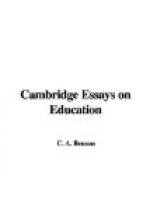been made to realise them by establishing a professional
Council with its necessary adjunct of a Register of
qualified persons. Seventy years ago the College
of Preceptors, with its grades of Associate, Licentiate
and Fellow, suggesting a comparison with the College
of Physicians, was established with the object of
“raising the standard of the profession by providing
a guarantee of fitness and respectability.”
The College Register was to contain the names of all
those who were qualified to conduct schools, and admission
to the Register was controlled by the College itself
in order to provide a means of excluding all who were
likely to bring discredit upon the calling of a teacher
by reason of their inefficiency or misconduct.
The scheme thus launched was, however, not comprehensive,
since it concerned chiefly the teachers who conducted
private schools and did not contemplate the inclusion
of those who were engaged in universities, public
schools, or the elementary schools working under the
then recently established scheme of State grants.
Teachers in schools of this last description were
apparently intended by the government of the day to
be regarded as civil servants, appointed and paid
by the State. Subsequent legislation modified
this arrangement, but teachers in schools receiving
government grants are still subject to a measure of
control, and those in public elementary schools are
licensed by the State before being allowed to teach.
It will be seen that the effort to organise a teaching
profession was hampered from the start by the fact
that teachers were not entirely free to set up their
own conditions, since the State had already taken
charge of one branch, while further difficulties arose
from the varied character of different forms of teaching
work and from the circumstance that some of these
forms were traditionally associated with membership
of another profession, that of a clergyman.
Hence it was that despite several attempts to institute
a Register of Teachers and to organise a profession
the difficulties seemed to be insurmountable.
Between the years 1869 and 1899 several bills were
introduced in Parliament with the object of setting
up a Register of Teachers but all met with opposition
and were abandoned. The Board of Education Act
of 1899 gave powers for constituting by Order in Council
a Consultative Committee to advise the Board on any
matter referred to the Committee and also to frame,
with the approval of the Board, regulations for a
Register of Teachers. It was not until 1902 that
an Order in Council established a Registration Council
and laid down regulations for the institution of a
Register. The Council thus established consisted
of twelve members, six of whom were nominated by the
President of the Board of Education while one was elected
by each of the following bodies: the Headmasters’
Conference, the Headmasters’ Association, the
Head Mistresses’ Association, the College of
Preceptors, the Teachers’ Guild, and the National




